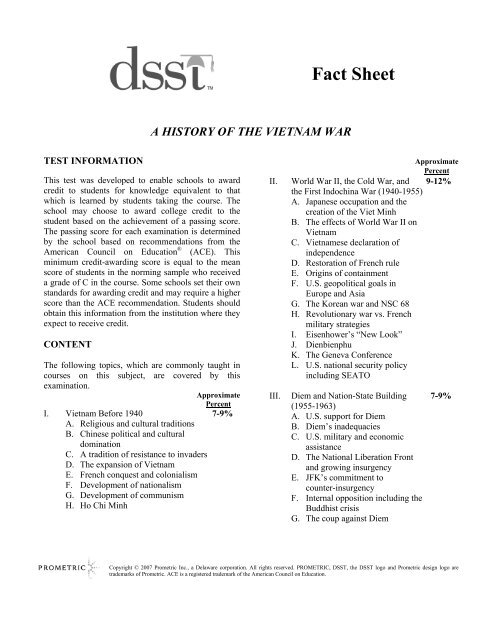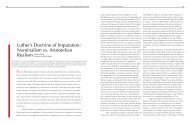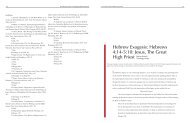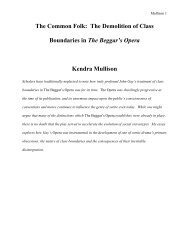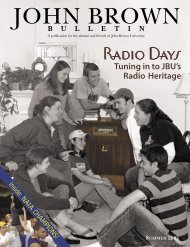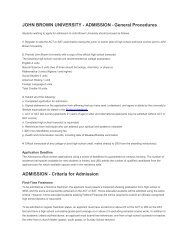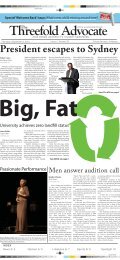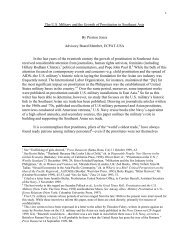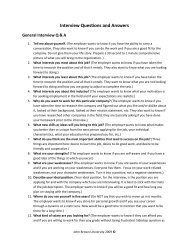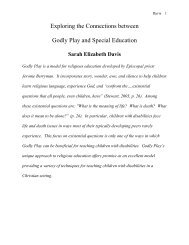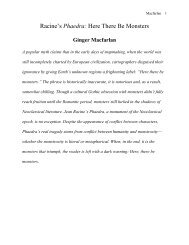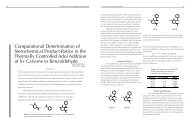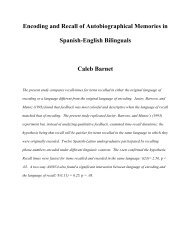A History of the Vietnam War - DSST | Get College Credit
A History of the Vietnam War - DSST | Get College Credit
A History of the Vietnam War - DSST | Get College Credit
Create successful ePaper yourself
Turn your PDF publications into a flip-book with our unique Google optimized e-Paper software.
Fact Sheet<br />
A HISTORY OF THE VIETNAM WAR<br />
TEST INFORMATION<br />
This test was developed to enable schools to award<br />
credit to students for knowledge equivalent to that<br />
which is learned by students taking <strong>the</strong> course. The<br />
school may choose to award college credit to <strong>the</strong><br />
student based on <strong>the</strong> achievement <strong>of</strong> a passing score.<br />
The passing score for each examination is determined<br />
by <strong>the</strong> school based on recommendations from <strong>the</strong><br />
American Council on Education ® (ACE). This<br />
minimum credit-awarding score is equal to <strong>the</strong> mean<br />
score <strong>of</strong> students in <strong>the</strong> norming sample who received<br />
a grade <strong>of</strong> C in <strong>the</strong> course. Some schools set <strong>the</strong>ir own<br />
standards for awarding credit and may require a higher<br />
score than <strong>the</strong> ACE recommendation. Students should<br />
obtain this information from <strong>the</strong> institution where <strong>the</strong>y<br />
expect to receive credit.<br />
CONTENT<br />
The following topics, which are commonly taught in<br />
courses on this subject, are covered by this<br />
examination.<br />
Approximate<br />
Percent<br />
I. <strong>Vietnam</strong> Before 1940 7-9%<br />
A. Religious and cultural traditions<br />
B. Chinese political and cultural<br />
domination<br />
C. A tradition <strong>of</strong> resistance to invaders<br />
D. The expansion <strong>of</strong> <strong>Vietnam</strong><br />
E. French conquest and colonialism<br />
F. Development <strong>of</strong> nationalism<br />
G. Development <strong>of</strong> communism<br />
H. Ho Chi Minh<br />
Approximate<br />
Percent<br />
II. World <strong>War</strong> II, <strong>the</strong> Cold <strong>War</strong>, and 9-12%<br />
<strong>the</strong> First Indochina <strong>War</strong> (1940-1955)<br />
A. Japanese occupation and <strong>the</strong><br />
creation <strong>of</strong> <strong>the</strong> Viet Minh<br />
B. The effects <strong>of</strong> World <strong>War</strong> II on<br />
<strong>Vietnam</strong><br />
C. <strong>Vietnam</strong>ese declaration <strong>of</strong><br />
independence<br />
D. Restoration <strong>of</strong> French rule<br />
E. Origins <strong>of</strong> containment<br />
F. U.S. geopolitical goals in<br />
Europe and Asia<br />
G. The Korean war and NSC 68<br />
H. Revolutionary war vs. French<br />
military strategies<br />
I. Eisenhower’s “New Look”<br />
J. Dienbienphu<br />
K. The Geneva Conference<br />
L. U.S. national security policy<br />
including SEATO<br />
III. Diem and Nation-State Building 7-9%<br />
(1955-1963)<br />
A. U.S. support for Diem<br />
B. Diem’s inadequacies<br />
C. U.S. military and economic<br />
assistance<br />
D. The National Liberation Front<br />
and growing insurgency<br />
E. JFK’s commitment to<br />
counter-insurgency<br />
F. Internal opposition including <strong>the</strong><br />
Buddhist crisis<br />
G. The coup against Diem<br />
Copyright © 2007 Prometric Inc., a Delaware corporation. All rights reserved. PROMETRIC, <strong>DSST</strong>, <strong>the</strong> <strong>DSST</strong> logo and Prometric design logo are<br />
trademarks <strong>of</strong> Prometric. ACE is a registered trademark <strong>of</strong> <strong>the</strong> American Council on Education.
Approximate<br />
Percent<br />
IV. LBJ Americanizes <strong>the</strong> <strong>War</strong> 7-9%<br />
(1964-1965)<br />
A. Political instability in <strong>Vietnam</strong><br />
B. Introduction <strong>of</strong> <strong>the</strong> North<br />
<strong>Vietnam</strong>ese Army<br />
C. The Tonkin Gulf Resolution<br />
D. The 1964 Campaign<br />
E. Flaming Dart to Rolling Thunder<br />
F. Introduction <strong>of</strong> U.S. combat troops<br />
(March through April 1965)<br />
G. U.S. openended commitment<br />
(July 1965)<br />
V. America Takes Charge (1965-1967) 7-9%<br />
A. Westmoreland’s strategy <strong>of</strong> attrition<br />
B. Measures <strong>of</strong> success<br />
C. The continuing air war<br />
D. The impact on <strong>Vietnam</strong>ese society<br />
E. Stabilization <strong>of</strong> <strong>the</strong> Saigon regime<br />
F. America’s draft army<br />
G. <strong>War</strong> without fronts<br />
VI. Homefront USA 7-9%<br />
A. The Great Society: guns vs. butter<br />
B. The credibility gap<br />
C. Congressional dissent<br />
D. Television and <strong>the</strong> press<br />
E. The civil rights movement<br />
F. The genesis <strong>of</strong> <strong>the</strong> new left<br />
G. The draft and draft resistance<br />
VII. Tet (1968) 7-9%<br />
A. <strong>Vietnam</strong>ese planning for <strong>the</strong><br />
Tet <strong>of</strong>fensive<br />
B. Communist objectives<br />
C. The Tet <strong>of</strong>fensive<br />
D. Reactions in U.S. and Saigon<br />
E. LBJ decides not to run<br />
F. Bombing halt and beginning <strong>of</strong><br />
peace talks<br />
G. The 1968 election<br />
VIII. <strong>Vietnam</strong>izing <strong>the</strong> <strong>War</strong> (1969-1973) 7-9%<br />
A. Nixon, Kissinger, and<br />
<strong>Vietnam</strong>ization<br />
B. Justifications for <strong>Vietnam</strong>ization<br />
(troop withdrawal)<br />
C. Pacification and <strong>the</strong> Phoenix<br />
program<br />
D. My Lai and <strong>the</strong> deterioration <strong>of</strong><br />
<strong>the</strong> U.S. military<br />
E. Secret negotiations (1969-1971)<br />
F. The 1972 Spring <strong>of</strong>fensive<br />
G. The October agreement<br />
H. The Christmas bombing<br />
I. Triangular diplomacy: <strong>the</strong> U.S.,<br />
<strong>the</strong> Soviet Union, and China<br />
J. Paris Peace Accords (1973)<br />
Approximate<br />
Percent<br />
IX. The <strong>War</strong> at Home 7-9%<br />
A. Campus unrest<br />
B. Peace activists and moratoria<br />
C. The Miami and Chicago<br />
conventions<br />
D. The counterculture, antiwar<br />
movement, and silent majority<br />
E. The Pentagon Papers<br />
X. Cambodia and Laos 7-9%<br />
A. The Geneva Accords (1954)<br />
B. JFK and Laotian neutrality (1962)<br />
C. The secret war in Laos<br />
D. Sihanouk and Cambodia’s<br />
neutrality<br />
E. Lon Nol and <strong>the</strong> U.S. incursion<br />
F. The secret bombing <strong>of</strong> Laos<br />
and Cambodia<br />
G. The Khmer Rouge and <strong>the</strong> fall<br />
<strong>of</strong> Phnom Penh (1975)<br />
H. The communist victory in Laos<br />
XI. “A Decent Interval” 5-7%<br />
A. The cease-fire violations<br />
B. Watergate and Nixon’s<br />
resignation<br />
C. Congressional passage <strong>of</strong> <strong>the</strong><br />
war powers act<br />
D. The Great Spring Offensive<br />
XII. U.S. Legacies and Lessons 7-9%<br />
A. The <strong>Vietnam</strong> Syndrome<br />
B. The Cold <strong>War</strong> consensus<br />
C. Congress vs. <strong>the</strong> President<br />
D. The experience <strong>of</strong> returning vets<br />
E. Economic consequences<br />
F. U.S., Soviet, Chinese relations<br />
G. The impact on <strong>the</strong> U.S. military<br />
H. The impact on <strong>the</strong> media<br />
I. POWs and MIAs<br />
J. Indochina refugees (boat people)<br />
K. Collective national amnesia<br />
2
Questions on <strong>the</strong> test require candidates to<br />
demonstrate <strong>the</strong> following abilities. Some questions<br />
may require more than one <strong>of</strong> <strong>the</strong> abilities.<br />
• Knowledge <strong>of</strong> basic facts and terms<br />
(about 55-65% <strong>of</strong> <strong>the</strong> examination)<br />
• Understanding <strong>of</strong> concepts and principles<br />
(about 15-25% <strong>of</strong> <strong>the</strong> examination)<br />
• Ability to apply knowledge to specific<br />
cases or issues<br />
(about 10-20% <strong>of</strong> <strong>the</strong> examination)<br />
SAMPLE QUESTIONS<br />
1. For which <strong>of</strong> <strong>the</strong> following reasons did<br />
Ho Chi Minh, a confirmed Communist, seek<br />
United States support in 1945<br />
(A)<br />
(B)<br />
(C)<br />
(D)<br />
He did not trust <strong>the</strong> Soviet Union<br />
He was a pragmatist, principally<br />
preoccupied with <strong>Vietnam</strong>’s salvation, and<br />
he would accept help where he could<br />
get it.<br />
He knew that he would be turned down by<br />
<strong>the</strong> Americans, and <strong>the</strong>n he could appeal<br />
more convincingly to <strong>the</strong> Soviets.<br />
He had no hope <strong>of</strong> United States aid, but<br />
o<strong>the</strong>rs in his administration urged him to<br />
appeal to <strong>the</strong> Americans.<br />
2. The Chinese Communist victory in 1949<br />
significantly altered <strong>the</strong> situation in Indochina<br />
because it resulted in<br />
(A) <strong>the</strong> introduction <strong>of</strong> large numbers <strong>of</strong> Chinese<br />
Communist troops into Indochina<br />
(B) provisions <strong>of</strong> war material and equipment to<br />
<strong>the</strong> Viet Minh<br />
(C) a shift <strong>of</strong> French military forces to <strong>the</strong><br />
nor<strong>the</strong>rn Indochina border<br />
(D) a formal military alliance between <strong>the</strong><br />
Chinese and <strong>Vietnam</strong>ese Communists<br />
3. Which <strong>of</strong> <strong>the</strong> following was one <strong>of</strong> <strong>the</strong><br />
important reasons why <strong>the</strong> United States<br />
military effort in South <strong>Vietnam</strong> was<br />
unsuccessful<br />
(A) The United States attempted to fight a<br />
conventional war against a guerrilla<br />
force that avoided large battles.<br />
(B) The United States measures only<br />
attracted <strong>the</strong> support <strong>of</strong> <strong>the</strong> peasant<br />
masses and failed to gain <strong>the</strong> support<br />
<strong>of</strong> <strong>the</strong> local elites.<br />
(C) Counterinsurgency could not have been<br />
adapted to <strong>the</strong> terrain in <strong>Vietnam</strong>.<br />
(D) Counterinsurgency was unpopular<br />
politically in <strong>the</strong> United States.<br />
4. One <strong>of</strong> <strong>the</strong> major counterinsurgency programs<br />
undertaken by <strong>the</strong> Diem government and <strong>the</strong><br />
Kennedy administration was <strong>the</strong><br />
(A) Phoenix program<br />
(B) Food-for-Peace program<br />
(C) Open Arms program<br />
(D) strategic hamlet program<br />
5. In early 1964, which <strong>of</strong> <strong>the</strong> following best<br />
describes <strong>the</strong> <strong>Vietnam</strong>ese Communists’<br />
position in South <strong>Vietnam</strong><br />
(A) They were weakened by <strong>the</strong> strategic<br />
hamlet program.<br />
(B) They were stronger in <strong>the</strong> cities than <strong>the</strong><br />
South <strong>Vietnam</strong>ese.<br />
(C) They controlled approximately 40% <strong>of</strong><br />
<strong>the</strong> countryside.<br />
(D) Their military successes outweighed<br />
<strong>the</strong>ir political successes.<br />
6. When <strong>the</strong> United States took charge <strong>of</strong> <strong>the</strong><br />
war, a major impact on <strong>Vietnam</strong>ese society<br />
was a dramatic<br />
(A) reduction in religious intolerance<br />
(B) expansion <strong>of</strong> political democracy<br />
(C) influx <strong>of</strong> money and technology<br />
(D) improvement in education<br />
3
7. What was <strong>the</strong> immediate reaction <strong>of</strong> President<br />
Johnson’s military and civilian advisors to <strong>the</strong><br />
outcome <strong>of</strong> <strong>the</strong> Tet <strong>of</strong>fensive<br />
I. They were divided over what course <strong>of</strong><br />
action to follow.<br />
II. They presented a united front in support<br />
<strong>of</strong> <strong>the</strong> President’s policies.<br />
III. They were unanimous in recommending<br />
<strong>the</strong> start <strong>of</strong> negotiations with <strong>the</strong><br />
Communists.<br />
IV. They urged <strong>the</strong> President to commit<br />
more troops to <strong>Vietnam</strong>.<br />
(A)<br />
(B)<br />
(C)<br />
(D)<br />
I and IV only<br />
II and III only<br />
III and IV only<br />
II, III and IV only<br />
8. Who were <strong>the</strong> Khmer Rouge<br />
(A)<br />
(B)<br />
(C)<br />
(D)<br />
Supporters <strong>of</strong> Prince Sihanouk<br />
Cambodian Communists<br />
The Cambodian non-Communist nationalists<br />
The pro-American faction in Cambodia<br />
9. “Credibility gap” was <strong>the</strong> phrase used to<br />
identify <strong>the</strong><br />
(A) victory claims <strong>of</strong> <strong>the</strong> <strong>Vietnam</strong>ese<br />
Communists<br />
(B) propaganda <strong>of</strong> <strong>the</strong> <strong>Vietnam</strong>ese Communists<br />
(C) distance between events and <strong>of</strong>ficial United<br />
States statements<br />
(D) disagreements between <strong>the</strong> United States<br />
and its allies over United States policy in<br />
<strong>Vietnam</strong><br />
10. The shooting <strong>of</strong> students at Kent State University<br />
came during demonstrations against <strong>the</strong><br />
(A) war in general<br />
(B) renewed bombing in <strong>the</strong> North<br />
(C) mining <strong>of</strong> Haiphong Harbor<br />
(D) invasion <strong>of</strong> Cambodia<br />
11. From <strong>the</strong> American perspective, one advantage <strong>of</strong><br />
<strong>the</strong> 1973 <strong>Vietnam</strong> Agreement was that it<br />
(A) allowed <strong>the</strong> return <strong>of</strong> United States prisoners<br />
<strong>of</strong> war<br />
(B) allowed some North <strong>Vietnam</strong>ese troops to<br />
stay in South <strong>Vietnam</strong><br />
(C) settled <strong>the</strong> political issues that caused<br />
<strong>the</strong> war<br />
(D) ended <strong>the</strong> war<br />
12. The <strong>War</strong> Powers Act was designed to<br />
ensure that<br />
(A) <strong>the</strong> President would have to obtain<br />
congressional support for long-term<br />
use <strong>of</strong> United States troops abroad<br />
(B) Congress would decide when and where<br />
to send United States troops<br />
(C) <strong>the</strong> President’s power to wage war<br />
would be virtually eliminated<br />
(D) a national referendum would have to be<br />
held before United States troops could<br />
be sent abroad<br />
STUDYING FOR THE EXAMINATION<br />
The following is a list <strong>of</strong> reference publications<br />
that were being used as textbooks in college<br />
courses <strong>of</strong> <strong>the</strong> same or similar title at <strong>the</strong> time <strong>the</strong><br />
test was developed. Appropriate textbooks for<br />
study are not limited to those listed below. If you<br />
wish to obtain study resources to prepare for <strong>the</strong><br />
examination, you may reference ei<strong>the</strong>r <strong>the</strong> current<br />
edition <strong>of</strong> <strong>the</strong> following titles or textbooks<br />
currently used at a local college or university for<br />
<strong>the</strong> same class title. It is recommended that you<br />
reference more than one textbook on <strong>the</strong> topics<br />
outlined in this fact sheet. You should begin by<br />
checking textbook content against <strong>the</strong> content<br />
outline included on <strong>the</strong> front page <strong>of</strong> this Fact<br />
Sheet before selecting textbooks that cover <strong>the</strong><br />
test content from which to study. Textbooks may<br />
be found at <strong>the</strong> campus bookstore <strong>of</strong> a local<br />
college or university <strong>of</strong>fering a course on <strong>the</strong><br />
subject.<br />
Sources for study material suggested but not<br />
limited to <strong>the</strong> following:<br />
The Public Broadcasting System video course,<br />
<strong>Vietnam</strong>: A Television <strong>History</strong>.<br />
Berman, Larry. Planning a Tragedy. New York:<br />
W.W. Norton & Co., current edition.<br />
de Benetetti, Charles. An American Ordeal: The<br />
Antiwar Movement <strong>of</strong> <strong>the</strong> <strong>Vietnam</strong> Era. Syracuse,<br />
New York: Syracuse University Press, current<br />
edition.<br />
Duiker, Willliam J. Sacred <strong>War</strong>: Nationalism and<br />
Revolution in a Divided <strong>Vietnam</strong>. New York,<br />
McGraw-Hill, Inc., current edition.<br />
4
Gardner, Lloyd, C. Approaching <strong>Vietnam</strong>: From<br />
World <strong>War</strong> II through Dienbienphu 1941-1954. New<br />
York, W.W. Norton & Co., current editon.<br />
Gelb, Leslie, and Richard Betts. The Irony <strong>of</strong> <strong>Vietnam</strong><br />
The System Worked. Washington, DC: Brookings,<br />
current edition.<br />
Hearden, Patrick, ed. <strong>Vietnam</strong>: Four American<br />
Perspectives. West Lafayette: Purdue, current edition.<br />
Herring, George C. America’s Longest <strong>War</strong>: The U.S.<br />
and <strong>Vietnam</strong> 1950-1975. New York: McGraw Hill,<br />
Inc., current edition.<br />
Hess, Gary R. <strong>Vietnam</strong> And The United States: Origins<br />
and Legacy <strong>of</strong> <strong>War</strong>. Boston, MA: Twayne Publishers,<br />
current edition.<br />
Issacs, Arnold. Without Honor: Defeat in <strong>Vietnam</strong> and<br />
Cambodia. New York: Vintage Books, current edition.<br />
Kahin, George McTurnan. Intervention: How America<br />
Became Involved in <strong>Vietnam</strong>. New York: Knopf,<br />
current edition.<br />
Karnow, Stanley. VIETNAM: A <strong>History</strong>. New York:<br />
Penguin USA, current edition.<br />
Kimball, Jeffrey P. To Reason Why: The Debate About<br />
Causes <strong>of</strong> U.S. Involvement in <strong>the</strong> <strong>Vietnam</strong> <strong>War</strong>. New<br />
York: McGraw-Hill, current edition.<br />
Krepinevich, Andrew. The Army and <strong>Vietnam</strong>.<br />
Baltimore: Johns Hopkins University Press, current<br />
edition.<br />
Maclear, Micharl. The Ten Thousand Days <strong>War</strong>:<br />
<strong>Vietnam</strong>, 1945-1975. New York: St. Martin’s, current<br />
edition.<br />
McMahon, Robert J. Major Problems in <strong>the</strong> <strong>History</strong> <strong>of</strong><br />
<strong>the</strong> <strong>Vietnam</strong> <strong>War</strong>. Lexington, MA, D.C. Heath and Co.<br />
current edition.<br />
Olson, James S., and Randy Roberts. Where <strong>the</strong><br />
Domino Fell: America and <strong>Vietnam</strong>, 1945 to 1995.<br />
New York, St. Martin’s Press, current edition.<br />
Palmer, General Bruce, Jr. The 25-Year <strong>War</strong>:<br />
America’s Military Role in <strong>Vietnam</strong>. Kentucky:<br />
The University Press <strong>of</strong> Kentucky, current edition<br />
Pratt, John Clark. <strong>Vietnam</strong> Voices: Perspectives on<br />
<strong>the</strong> <strong>War</strong> Years, 1941-1982. New York: Viking-<br />
Penguin Books, current edition.<br />
Race, Jeffrey. <strong>War</strong> Comes to Long An. Berkeley,<br />
CA: University <strong>of</strong> California Press, current<br />
edition.<br />
Rotter, Andrew J. The Path to <strong>Vietnam</strong>: Origins <strong>of</strong><br />
<strong>the</strong> American Commitment to Sou<strong>the</strong>ast Asia.<br />
Ithaca: Cornell, current edition.<br />
Schulzinger, Robert D. A Time for <strong>War</strong>: The<br />
United States and <strong>Vietnam</strong>, 1941-1975. New<br />
York: Oxford, current edition.<br />
Sheehan, Neil. A Bright Shining Lie: John Paul<br />
Vann and America in <strong>Vietnam</strong>. New York:<br />
Random House, current edition.<br />
Williams, William Appleman, Thomas<br />
McCormick, Lloyd Gardner, and Walter LaFeber.<br />
America in <strong>Vietnam</strong>: A Documentary <strong>History</strong>.<br />
New York: W. W. Norton, current edition.<br />
Current textbook used by a local college or<br />
university for a course on <strong>the</strong> subject.<br />
CREDIT RECOMMENDATIONS<br />
The Center For Adult Learning and Educational<br />
Credentials <strong>of</strong> <strong>the</strong> American Council on Education<br />
(ACE) has reviewed and evaluated <strong>the</strong> <strong>DSST</strong><br />
examination development process. The American<br />
Council on Education has made <strong>the</strong> following<br />
recommendations:<br />
Moss, George Donelson. <strong>Vietnam</strong>: An American<br />
Ordeal. Englewood Cliffs, NJ: Prentice Hall, current<br />
edition.<br />
Area or Course<br />
Equivalent:<br />
<strong>War</strong><br />
Level:<br />
Amount <strong>of</strong> <strong>Credit</strong>:<br />
Source:<br />
A <strong>History</strong> <strong>of</strong> <strong>the</strong> <strong>Vietnam</strong><br />
Lower-level baccalaureate<br />
Three (3) semester hours<br />
ACE Commission on<br />
Educational <strong>Credit</strong><br />
and Credentials<br />
5
INFORMATION<br />
<strong>College</strong>s and universities that would like additional<br />
information about <strong>the</strong> national norming, or assistance<br />
in local norming or score validation studies should<br />
write to: <strong>DSST</strong> Program, Prometric, 2000 Lenox<br />
Drive, 3rd Floor, Lawrenceville, NJ 08648.<br />
It is advisable that schools develop a consistent<br />
policy about awarding credit based on scores from<br />
this test and that <strong>the</strong> policy be reviewed<br />
periodically. Prometric will be happy to help<br />
schools in this effort.<br />
Rev. 20071115 – I.N. 390473<br />
6


